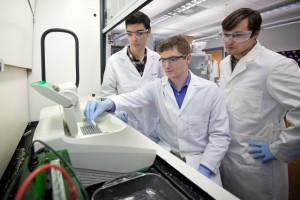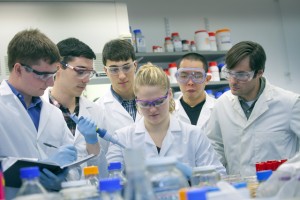Professor Justin Hines and his team of student researchers could be one step closer to understanding neurodegenerative diseases such as Alzheimer’s and Parkinson’s.

Zachary Sporn ’15, Michael Rockman ’17 and Professor Justin Hines work in a lab in Hugel Science Center.
Hines, assistant professor of chemistry, has received a three-year, $268,220 research grant from the National Institutes of Health (NIH) for his study on how the interaction among proteins in the body can lead to disease.
Five biochemistry majors are working on projects in Hines’ lab through grant funding. They presented research with him at the American Society for Cell Biology/International Federation for Cell Biology joint meeting:
- Michael Rockman ’15 of Chapel Hill, North Carolina
- Zachary Sporn ’16 of Athens, Pennsylvania
- Michael Astor ’17 of Ogdensburg, New Jersey
- Quang Bui ’17 of Ho Chi Minh City, Vietnam
- Emily Oliver ’17 of Westminster, Colorado
Hines studies model proteins in baker’s yeast. Proteins accomplish nearly every function of a living organism, explains Hines, and sometimes, those proteins change shape and stick together, or aggregate, in ways that lead to disease. Hines studies how a group of proteins called molecular chaperones prevents other proteins from aggregating.
“The chaperones that we study in yeast have amazing properties that we still don’t fully understand,” he says. “For example, they are particularly good at dealing with a specific type of aggregate called an amyloid, which is associated with Alzheimer’s, Parkinson’s, and many other neurodegenerative diseases in humans. In yeast, prion proteins become amyloids, but amazingly, instead of killing the yeast, chaperone proteins are able to manage these aggregates. We don’t understand the biochemistry that explains how these chaperone proteins do this, but it is certainly an important and intriguing question.”

Michael Rockman ’15, Zachary Sporn ’16, Michael Astor ’17, Emily Oliver ’17, Quang Bui ’17 and Professor Justin Hines explore the connection between proteins and disease in the body.
Hines points out that as the population ages and life expectancies increase, neurodegenerative diseases associated with amyloid formations are on the rise. A better understanding of how chaperone proteins prevent protein aggregation could lead to better treatments, and even cures, for some of those disorders.
Preliminary data collected by students through Lafayette’s EXCEL Scholars undergraduate research program was critical in securing the grant. Hines co-authored an article for the journal PLoS Genetics with biochemistry graduates Milan Patel ’12 and Julia Harris ’13, biology graduate Phil Nguyen ’14, and Sporn.
The NIH grant is an Academic Research Enhancement Award through the National Institute of General Medical Sciences.

